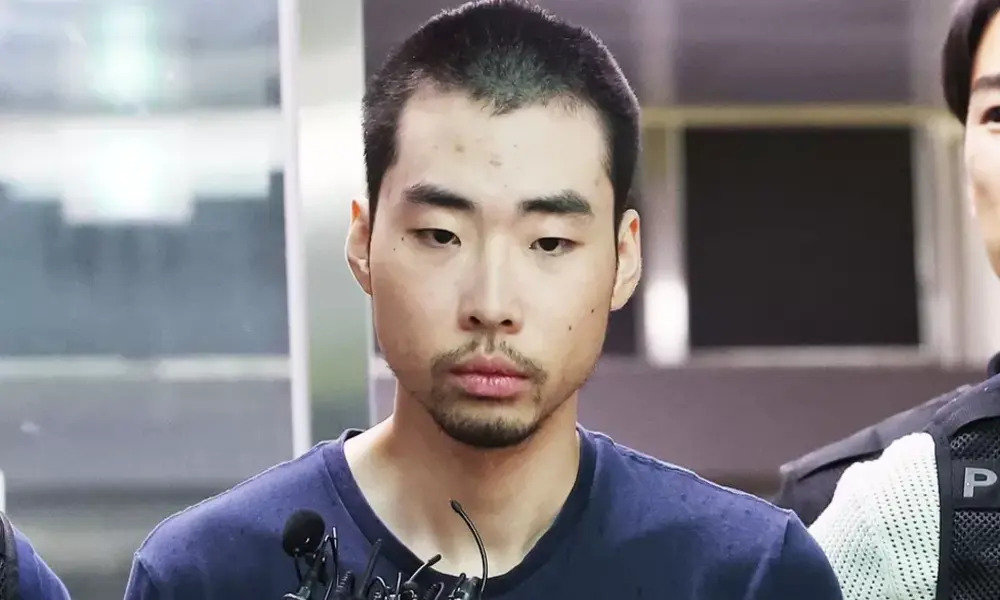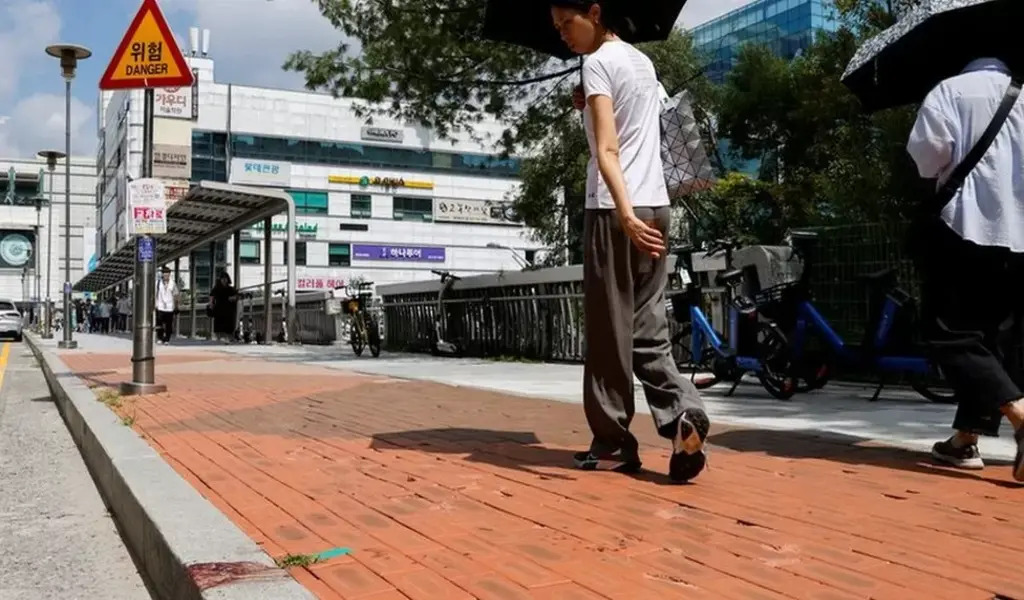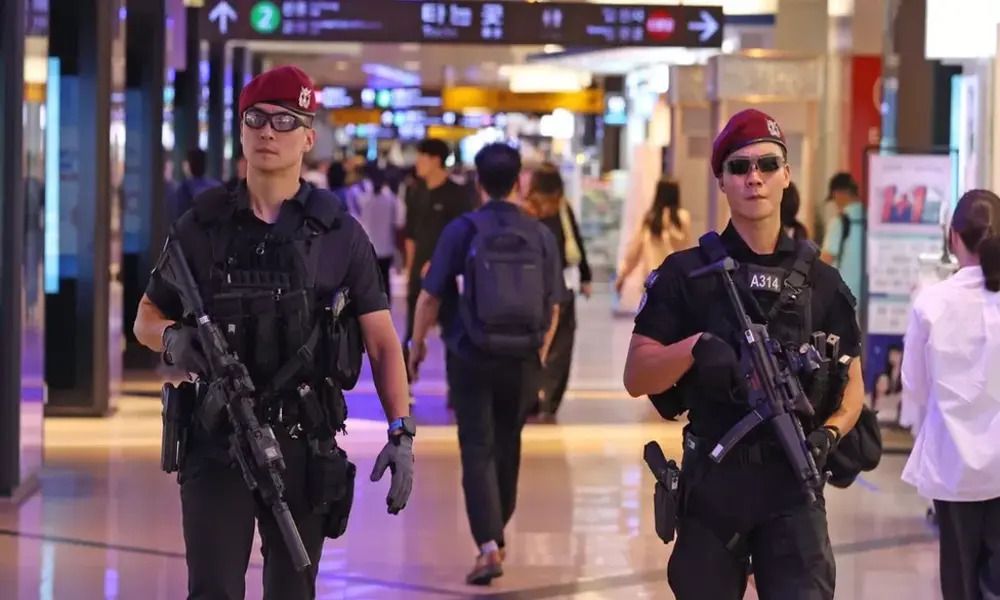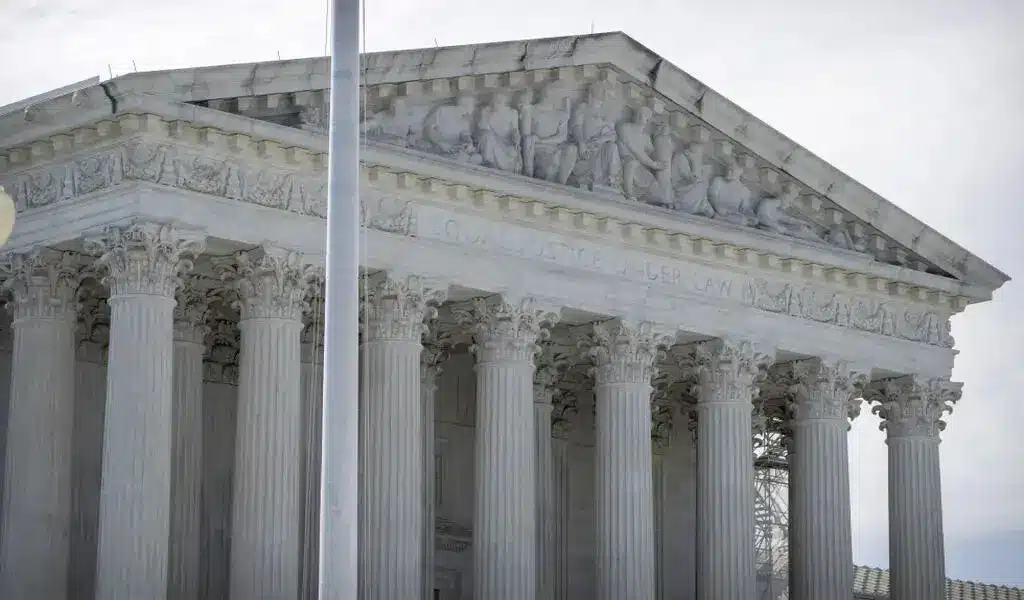News
“Don’t Ask Why”: South Korea’s Struggle With Recent Spate Of Stabbings And Online Threats

(CTN NEWS) – A chilling scene unfolded within a crowded subway car as a knife swiftly emerged, sending shivers down the spines of onlookers. A malefactor, in hot pursuit of innocent shoppers, unleashed a frenzy of wild stabbings on a bustling street.
These harrowing nightmares have haunted the thoughts of numerous South Koreans in the wake of a recent spate of mass stabbing incidents – the second such occurrence in as many weeks for the country.
On August 3rd, in Seongnam, situated to the southeast of Seoul, the tranquility was shattered as a man plowed his car into pedestrians near a subway station, then bolted into a department store. Inside, he proceeded to wield his blade, leaving nine individuals wounded and tragically claiming the life of a woman who succumbed to her injuries later.
In the aftermath, bewildered citizens took to the online sphere, their voices a mix of distress and astonishment, questioning the state of affairs in South Korea.
Accustomed to a reputation for minimal violent crime, they grappled with the recent back-to-back stabbings that seemed to defy their nation’s prevailing image of safety.
“Once hailed as one of the world’s safest havens, what has befallen South Korea?” wondered one individual in a YouTube comment, articulating the collective sentiment.

Echoes of Disturbing Inspiration: Unraveling the Connection Between Consecutive Attacks in South Korea
Merely days before, on July 21st, a separate assailant had launched an attack on commuters within the capital city, claiming the life of one person and inflicting stab wounds upon three others at a subway station.
Subsequent police interviews revealed his motive – a desire to share his misery by inflicting it upon others.
Evidently, the second attacker took inspiration from his predecessor’s actions, as later findings would indicate.
The suspect, a 22-year-old named Choi Won-jong, had a history marked by struggles.
A delivery driver and a high-school dropout diagnosed with schizoid personality disorder, he had actively sought information about the initial assault at Sillim Station, suggesting a disturbing semblance of emulation.
These unnerving incidents have left a nation grappling with the unexpected, redefining their perception of security and prompting introspection into the roots of these unsettling events.
Navigating the Enigma of “Don’t Ask Why” Crimes in South Korea: Unraveling Motives Amidst Rising Concerns
In South Korea, a perplexing phenomenon known as “Don’t Ask Why” or Mudjima crimes has emerged – instances of unexplainable violence directed at strangers, devoid of any apparent personal connection to the victims or discernible motives.
While the public had been using the term Mudjima for years, it wasn’t until 2022 that South Korean law enforcement officially categorized such acts as a distinct type: “Abnormal Motive Crimes”.
With clear definitions established and a dedicated task force established to combat these crimes, this move seemed to signify a newfound seriousness on the part of authorities. In the first half of the current year, 18 Mudjima incidents were documented by the police.
Despite general statistics indicating no surge in violent crime – in fact, South Korea registered its lowest rates in a decade last year – the recent spate of stabbings has fostered a perception that Mudjima occurrences are more frequent, rendering society seemingly more perilous.
This perception has even fueled some individuals to draw parallels with the United States, leading to online commentary such as: “The American mentality is spreading in South Korea” and “OMG, South Korea is becoming the USA of Asia.”
Nevertheless, experts maintain that South Korea remains a remarkably secure nation.
“Comparatively, homicide and other forms of violent crime are exceedingly rare, both in historical context and relative to other countries. The trend has been a consistent decline over the past decade,” stated Professor Hyojong Song, a criminology authority at Korea University in Seoul.
South Korea’s homicide rate, resting at 1.3 murders per 100,000 individuals, stands at half the average of OECD nations and less than a fifth of America’s homicide rate. Moreover, stringent gun control measures are in place.
Many online voices argued that the oversimplified comparisons with the US obfuscate the genuine need for local authorities to address the underlying social issues contributing to these incidents:
“It’s imperative to examine South Korea’s unique social challenges that have contributed to this situation,” penned one user.

As details about the perpetrators remain vague, the limited information disclosed thus far has already ignited public conjecture and ire.
“In this era, we’re witnessing unemployed individuals venting their frustrations on innocent people,” one TikTok user commented, reflecting a prevailing sentiment observed across various online platforms.
Similarly, a commenter on YouTube contended, “In the past, only individuals with psychopathic tendencies would engage in such acts, but nowadays, we find ourselves in a world where ordinary people are turning into perpetrators of violence.
The lack of hope, heightened anxiety, and diminished sense of happiness are prevailing.”
Experts have shed light on the underlying societal pressures within South Korea, ranging from precarious job prospects and housing insecurity to enduring stigmas related to mental well-being and a deficiency of support services.
Authorities revealed that Choi had not received adequate treatment.
“In essence, I believe that we urgently require emotionally and practically oriented social support systems or policies that can aid those who feel detached from society, lacking social connections,” Professor Song emphasized during an interview with the BBC.
Amidst Stabbing Fears, Online Threats Fuel Public Unease and Vigilance
What exacerbated ongoing public apprehension following the stabbing incident last week was the surge of menacing threats that emerged, promising imitative attacks.
These online declarations delineated precise timings and locations, some even specifying the gender of intended victims to be targeted. Alarming words such as “kill as many people as possible” echoed through these posts.
While some brushed aside these declarations as the antics of adolescents and attention-seekers, they undeniably succeeded in rattling the populace.
Across social media platforms, vigilant users disseminated alerts for the weekend spanning August 4th to 6th. One TikTok video, garnering over 300,000 views across Asia, bore the message: “Please steer clear of these South Korean areas.”
The host, a North American expatriate residing in Seoul, shared a list of prospective stabbing locations, including several subway stations, nightlife districts, an amusement park, and a women’s university stop.
“Feel free to capture this screenshot – here’s a compilation of potential public stabbing sites for the weekend,” the host stated in the video, coupled with words of caution: “Remain vigilant, stay aware of your surroundings, and prioritize your safety out there.”
In response, the police initiated a “special enforcement” operation for the designated weekend, deploying a considerable augmentation of officers to public locales.
These law enforcement personnel were tasked with halting and inspecting individuals appearing “suspicious” – a measure that led to at least one arrest after an individual was spotted carrying knives in a public setting.

Cracking Down on Online Threats and Responding to Apprehensions
Authorities also took decisive action against the online threats, diligently tracking individuals throughout the nation by tracing their internet service addresses and acting upon tip-offs.
In the aftermath of the weekend operation, law enforcement divulged that they had pinpointed nearly 200 threats and taken approximately 60 individuals into custody.
Notably, 34 of these apprehended individuals were teenagers, with several being 14 years old or younger and thus exempt from criminal prosecution.
Among the detained, a 17-year-old boy found himself in custody for issuing a stabbing threat at a train station in Wonju, only to subsequently report the threat to the police under the guise of a tip-off.
In a separate incident, a 14-year-old was arrested near the subway station he had identified as a target. When questioned, he informed authorities that he had no intention of committing murder; his motive for the online post was mere boredom, and he had shared it as a jest.
As successive days unfold without further incidents, some of the immediate tension gripping the public begins to wane. Yet, a sense of apprehension continues to linger in the minds of many.
An increasing number of individuals have opted to carry protective items like mace sprays, and within crowded places such as subway platforms, vigilance is palpable as people remain watchful of their surroundings and those nearby.
Just this past Saturday, exuberant fans aboard a night train returning from a concert featuring a member of BTS inadvertently triggered a near stampede.
Developments and Responses in the Wake of Recent Terrifying Incidents
The jubilant cries of these fans were misconstrued as terror, prompting passengers to flee. Those who fled later likened their experience to scenes from a zombie film.
A newly established web service designed to map online threats reportedly amassed over 50,000 views within its initial days of operation, as per local media reports. This platform continues to document new threats on a daily basis.
Korean media disclosed on Wednesday that police managed to identify the originator of an online threat a mere eight minutes after its dissemination.
These “acts of terror” have kindled discourse within the political sphere, prompting discussions on bolstering measures against crime.
In the past week, legislators have pledged to institute more stringent penalties for mass stabbings, lower the age of criminal responsibility, and amend legislation to legitimize assertive police interventions.
On Monday, the nation’s justice minister expressed the viewpoint that police use of force should be perceived as an act of self-defense.
An editorial featured this week in the Korean Herald succinctly encapsulated the sentiments of many: “The perpetration of such violent crimes in a nation renowned for its relatively high levels of public safety is profoundly shocking.
“A comprehensive inquiry to unearth the specific motives behind these horrifying crimes is imperative. Concurrently, the police must implement measures to forestall the emergence of imitative offenses.”
RELATED CTN NEWS:
U Visa: How A Visa Program Meant To Assist Law Enforcement Puts Immigrant Victims At Risk
Tragic Consequences: Heavy Rainfall Spurs Evacuations And Fatal Mudslide in China’s Southwest
Saudi Arabia’s Vigorous Bid To Join GCAP: Alliance Tensions And Prospective Contributions

News
Google’s Search Dominance Is Unwinding, But Still Accounting 48% Search Revenue

Google is so closely associated with its key product that its name is a verb that signifies “search.” However, Google’s dominance in that sector is dwindling.
According to eMarketer, Google will lose control of the US search industry for the first time in decades next year.
Google will remain the dominant search player, accounting for 48% of American search advertising revenue. And, remarkably, Google is still increasing its sales in the field, despite being the dominating player in search since the early days of the George W. Bush administration. However, Amazon is growing at a quicker rate.
Google’s Search Dominance Is Unwinding
Amazon will hold over a quarter of US search ad dollars next year, rising to 27% by 2026, while Google will fall even more, according to eMarketer.
The Wall Street Journal was first to report on the forecast.
Lest you think you’ll have to switch to Bing or Yahoo, this isn’t the end of Google or anything really near.
Google is the fourth-most valued public firm in the world. Its market worth is $2.1 trillion, trailing just Apple, Microsoft, and the AI chip darling Nvidia. It also maintains its dominance in other industries, such as display advertisements, where it dominates alongside Facebook’s parent firm Meta, and video ads on YouTube.
To put those “other” firms in context, each is worth more than Delta Air Lines’ total market value. So, yeah, Google is not going anywhere.
Nonetheless, Google faces numerous dangers to its operations, particularly from antitrust regulators.
On Monday, a federal judge in San Francisco ruled that Google must open up its Google Play Store to competitors, dealing a significant blow to the firm in its long-running battle with Fortnite creator Epic Games. Google announced that it would appeal the verdict.
In August, a federal judge ruled that Google has an illegal monopoly on search. That verdict could lead to the dissolution of the company’s search operation. Another antitrust lawsuit filed last month accuses Google of abusing its dominance in the online advertising business.
Meanwhile, European regulators have compelled Google to follow tough new standards, which have resulted in multiple $1 billion-plus fines.

Pixa Bay
Google’s Search Dominance Is Unwinding
On top of that, the marketplace is becoming more difficult on its own.
TikTok, the fastest-growing social network, is expanding into the search market. And Amazon has accomplished something few other digital titans have done to date: it has established a habit.
When you want to buy anything, you usually go to Amazon, not Google. Amazon then buys adverts to push companies’ products to the top of your search results, increasing sales and earning Amazon a greater portion of the revenue. According to eMarketer, it is expected to generate $27.8 billion in search revenue in the United States next year, trailing only Google’s $62.9 billion total.
And then there’s AI, the technology that (supposedly) will change everything.
Why search in stilted language for “kendall jenner why bad bunny breakup” or “police moving violation driver rights no stop sign” when you can just ask OpenAI’s ChatGPT, “What’s going on with Kendall Jenner and Bad Bunny?” in “I need help fighting a moving violation involving a stop sign that wasn’t visible.” Google is working on exactly this technology with its Gemini product, but its success is far from guaranteed, especially with Apple collaborating with OpenAI and other businesses rapidly joining the market.
A Google spokeswoman referred to a blog post from last week in which the company unveiled ads in its AI overviews (the AI-generated text that appears at the top of search results). It’s Google’s way of expressing its ability to profit on a changing marketplace while retaining its business, even as its consumers steadily transition to ask-and-answer AI and away from search.

Google has long used a single catchphrase to defend itself against opponents who claim it is a monopoly abusing its power: competition is only a click away. Until recently, that seemed comically obtuse. Really? We are going to switch to Bing? Or Duck Duck Go? Give me a break.
But today, it feels more like reality.
Google is in no danger of disappearing. However, every highly dominating company faces some type of reckoning over time. GE, a Dow mainstay for more than a century, was broken up last year and is now a shell of its previous dominance. Sears declared bankruptcy in 2022 and is virtually out of business. US Steel, long the foundation of American manufacturing, is attempting to sell itself to a Japanese corporation.
SOURCE | CNN
News
2024 | Supreme Court Won’t Hear Appeal From Elon Musk’s X Platform Over Warrant In Trump Case

Washington — Trump Media, The Supreme Court announced Monday that it will not hear an appeal from social media platform X about a search warrant acquired by prosecutors in the election meddling case against former President Donald Trump.
The justices did not explain their rationale, and there were no recorded dissents.
The firm, which was known as Twitter before being purchased by billionaire Elon Musk, claims a nondisclosure order that prevented it from informing Trump about the warrant obtained by special counsel Jack Smith’s team violated its First Amendment rights.
The business also claims Trump should have had an opportunity to exercise executive privilege. If not reined in, the government may employ similar tactics to intercept additional privileged communications, their lawyers contended.
Supreme Court Won’t Hear Appeal From Elon Musk’s X Platform Over Warrant In Trump Case
Two neutral electronic privacy groups also joined in, urging the high court to hear the case on First Amendment grounds.
Prosecutors, however, claim that the corporation never shown that Trump utilized the account for official purposes, therefore executive privilege is not a problem. A lower court also determined that informing Trump could have compromised the current probe.

Trump utilized his Twitter account in the weeks preceding up to his supporters’ attack on the Capitol on January 6, 2021, to spread false assertions about the election, which prosecutors claim were intended to create doubt in the democratic process.
The indictment describes how Trump used his Twitter account to encourage his followers to travel to Washington on Jan. 6, pressuring Vice President Mike Pence to reject the certification, and falsely claiming that the Capitol crowd, which battered police officers and destroyed glass, was peaceful.
Supreme Court Won’t Hear Appeal From Elon Musk’s X Platform Over Warrant In Trump Case
That case is now moving forward following the Supreme Court’s verdict in July, which granted Trump full immunity from criminal prosecution as a former president.
The warrant arrived at Twitter amid quick changes implemented by Musk, who bought the company in 2022 and has since cut off most of its workforce, including those dedicated to combating disinformation and hate speech.
SOURCE | AP
News
The Supreme Court Turns Down Biden’s Government Appeal in a Texas Emergency Abortion Matter.

(VOR News) – A ruling that prohibits emergency abortions that contravene the Supreme Court law in the state of Texas, which has one of the most stringent abortion restrictions in the country, has been upheld by the Supreme Court of the United States. The United States Supreme Court upheld this decision.
The justices did not provide any specifics regarding the underlying reasons for their decision to uphold an order from a lower court that declared hospitals cannot be legally obligated to administer abortions if doing so would violate the law in the state of Texas.
Institutions are not required to perform abortions, as stipulated in the decree. The common populace did not investigate any opposing viewpoints. The decision was made just weeks before a presidential election that brought abortion to the forefront of the political agenda.
This decision follows the 2022 Supreme Court ruling that ended abortion nationwide.
In response to a request from the administration of Vice President Joe Biden to overturn the lower court’s decision, the justices expressed their disapproval.
The government contends that hospitals are obligated to perform abortions in compliance with federal legislation when the health or life of an expectant patient is in an exceedingly precarious condition.
This is the case in regions where the procedure is prohibited. The difficulty hospitals in Texas and other states are experiencing in determining whether or not routine care could be in violation of stringent state laws that prohibit abortion has resulted in an increase in the number of complaints concerning pregnant women who are experiencing medical distress being turned away from emergency rooms.
The administration cited the Supreme Court’s ruling in a case that bore a striking resemblance to the one that was presented to it in Idaho at the beginning of the year. The justices took a limited decision in that case to allow the continuation of emergency abortions without interruption while a lawsuit was still being heard.
In contrast, Texas has been a vocal proponent of the injunction’s continued enforcement. Texas has argued that its circumstances are distinct from those of Idaho, as the state does have an exemption for situations that pose a significant hazard to the health of an expectant patient.
According to the state, the discrepancy is the result of this exemption. The state of Idaho had a provision that safeguarded a woman’s life when the issue was first broached; however, it did not include protection for her health.
Certified medical practitioners are not obligated to wait until a woman’s life is in imminent peril before they are legally permitted to perform an abortion, as determined by the state supreme court.
The state of Texas highlighted this to the Supreme Court.
Nevertheless, medical professionals have criticized the Texas statute as being perilously ambiguous, and a medical board has declined to provide a list of all the disorders that are eligible for an exception. Furthermore, the statute has been criticized for its hazardous ambiguity.
For an extended period, termination of pregnancies has been a standard procedure in medical treatment for individuals who have been experiencing significant issues. It is implemented in this manner to prevent catastrophic outcomes, such as sepsis, organ failure, and other severe scenarios.
Nevertheless, medical professionals and hospitals in Texas and other states with strict abortion laws have noted that it is uncertain whether or not these terminations could be in violation of abortion prohibitions that include the possibility of a prison sentence. This is the case in regions where abortion prohibitions are exceedingly restrictive.
Following the Supreme Court’s decision to overturn Roe v. Wade, which resulted in restrictions on the rights of women to have abortions in several Republican-ruled states, the Texas case was revisited in 2022.
As per the orders that were disclosed by the administration of Vice President Joe Biden, hospitals are still required to provide abortions in cases that are classified as dire emergency.
As stipulated in a piece of health care legislation, the majority of hospitals are obligated to provide medical assistance to patients who are experiencing medical distress. This is in accordance with the law.
The state of Texas maintained that hospitals should not be obligated to provide abortions throughout the litigation, as doing so would violate the state’s constitutional prohibition on abortions. In its January judgment, the 5th United States Circuit Court of Appeals concurred with the state and acknowledged that the administration had exceeded its authority.
SOURCE: AP
SEE ALSO:
Could Last-Minute Surprises Derail Kamala Harris’ Campaign? “Nostradamus” Explains the US Poll.
-

 News4 years ago
News4 years agoLet’s Know About Ultra High Net Worth Individual
-
Entertainment2 years ago
Mabelle Prior: The Voice of Hope, Resilience, and Diversity Inspiring Generations
-
News11 years ago
Enviromental Groups Tell Mekong Leaders Lao Dam Evaluation Process Flawed
-

 Health4 years ago
Health4 years agoHow Much Ivermectin Should You Take?
-

 Tech3 years ago
Tech3 years agoTop Forex Brokers of 2023: Reviews and Analysis for Successful Trading
-

 Lifestyles3 years ago
Lifestyles3 years agoAries Soulmate Signs
-

 Entertainment3 years ago
Entertainment3 years agoWhat Should I Do If Disney Plus Keeps Logging Me Out of TV?
-

 Health3 years ago
Health3 years agoCan I Buy Ivermectin Without A Prescription in the USA?


